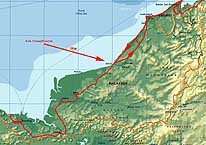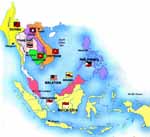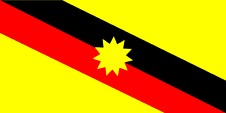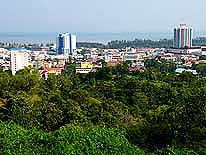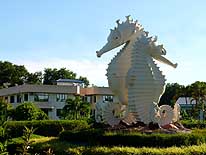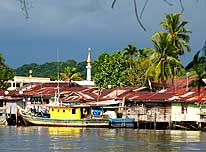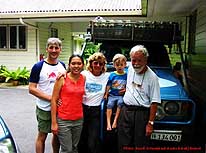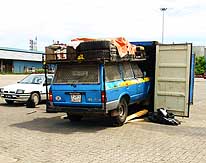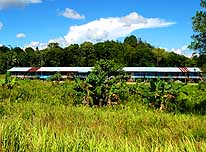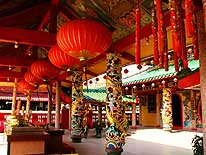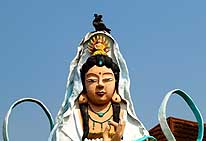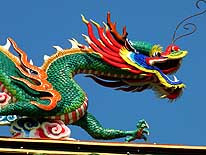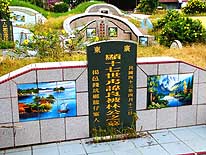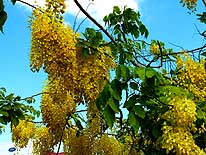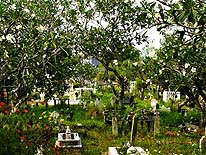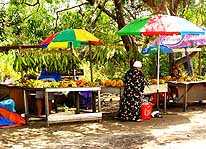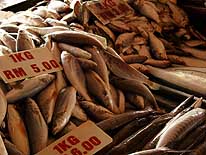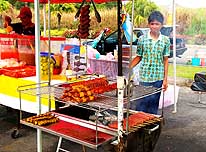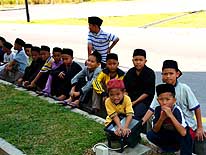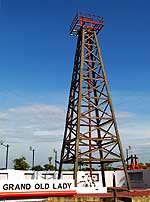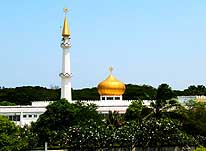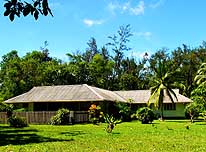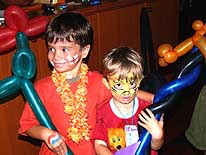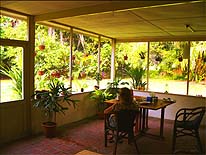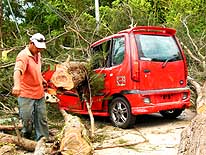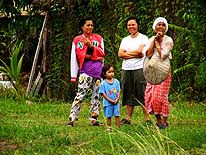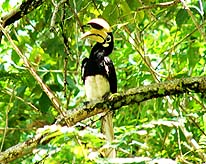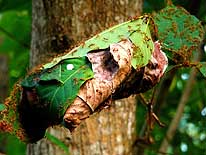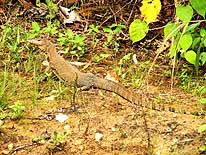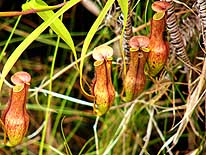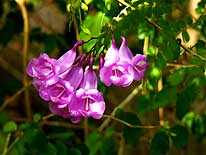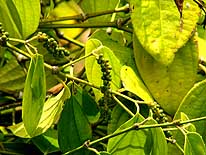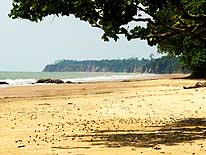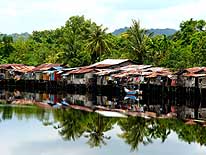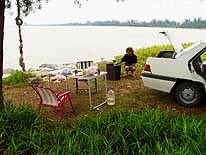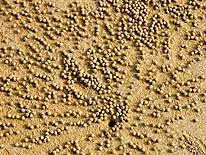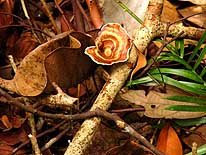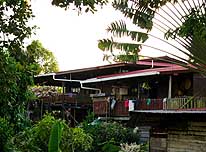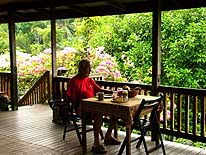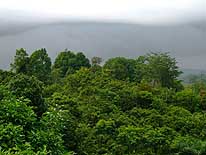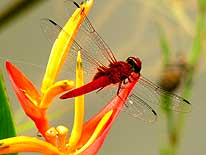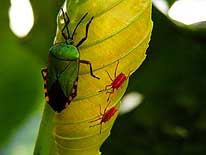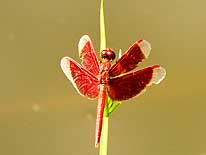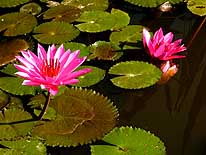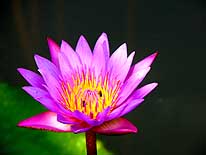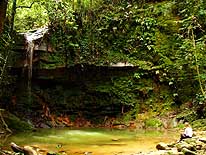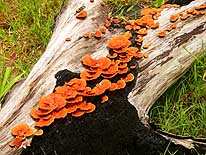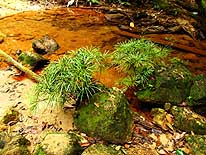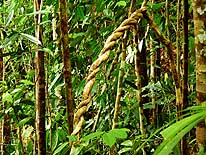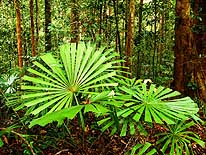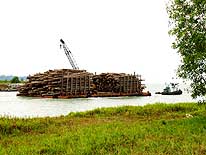- Enjoy some pictures of the worldrecordtour, taken in Sarawak,
- the East Malaysian Province on Borneo - Part 1: Northeast (Miri)
|
||||
Sarawak
|
Malaysia
|
|||
More websites from Borneo:
|
||||
|
|
|
||
|
|
|
||
| Sarawak - "Land of the Hornbill" – "MIRI" (Part 1)
|
||||
|
|
|
||
| Full of anticipation, we step out of the cool arriving hall and spot immediately Linde walking with her two little boys Samuel and Robert with a big smile towards us. What a lovely welcome! We met Linde and her husband Richard during our third visit to the Sultanate of Oman in 1999 – which still remains one of our favorite countries in the world. By then, their children were not yet born and we have only now the chance to hug these two gentle and affectionate little boys for the first time. They find their way straight away into our hearts! While we are driving to their home in the Shell-Camp, which shows to be a spacious traditional wooden house in a tropical surrounding, we recall how we first met. All started with a big fish and three weather-beaten wild looking fishermen in the tiny fishing village of Ras Madrakah in Southern Oman. We camped the night at the picturesque white sandy beach and were enjoying our breakfast when the men returned from their early morning catch. When they spotted us, they proudly showed us the big species they had caught and asked us to take a picture of them. As a testimony of the legendary hospitality of the Omani people, they charmingly insisted, that we accept one of their fishes, not knowing though, that their noble gesture would put us in some kind of embarrassment. Firstly, Emil does not like fish at all, and secondly, we had no space left in our small 12-Volt Engel fridge to keep it fresh in the fierce desert heat anyway. What were we going to do? Not wanting to throw it away, we decided to pass it on to the very first persons crossing our way. And these people just happened to be Linde and Richard. One week later, we were their guests in their house at the Shell-Camp in Muscat!
|
||||
|
|
|
||
| Now, seven years later, we are their guests again and again in a spacious Shell-Camp. However, this time we are surrounded by luxury tropical vegetation instead of a sandy desert scene. On a small scale, we find our dream from a tropical haven a bit fulfilled right here. Everything seems to be exaggerated – the deep green and the variety of orchids. On a tree branch, a hornbill family with yellow peaks is greeting us – by the indigenous Iban tribe believed to be messengers from the spirit world. There is no doubt – we have really chosen the right corner of the world for the urgently needed “all round rejuvenation” of our battered LandCruiser, momentarily still sailing somewhere between West and East Malaysia towards the small port of Bintulu in the South. One of the major reasons we have chosen Sarawak certainly was, that Linde and Richard offered us their beautiful place to unload and store all our stuff, while fixing the rusted body of our car and overhauling the engine. Another, not less important reason though was, that their neighbor and friend Roddy recommended us a reliable body shop, where he recently also overhauled his own car – a LandCruiser FJ60 too (after more evaluation though, we finally assigned someone else with the repairs). And what we did not know before, but helps now as well with some eventually needed body parts, is that both – Sarawak and Sabah – are “LandCruiser countries” and the sight of good old 60’s is not uncommon on the roads, but unfortunately only the diesel version. Then, the Island of Borneo is also an easy jump-off point for our next two planned new destinations – the Philippines (ferry) and Indonesia (road). And, of course, it is also the irresistible call of the rainforest with its different tribal people and distinctive, exotic wildlife that greatly attracted us. The name “Borneo” had been in our thoughts and dreams already for a long time, and we are happy to finally be in this new world.
|
||||
|
|
|
||
| Six days after our arrival in Miri, a comfortable local airconditioned bus, its radio blaring in full force, takes us through the interior road – supposed to be more picturesque than the newly built coastal road – to the more Southerly port of Bintulu, to get our house on wheels released. While driving the 125 miles, we slowly start to realize, that a considerable part of dense rainforest has already been carried away by the rush of excessive logging and replaced by huge, profitable palm-oil plantations. This applies by the way to many parts of the state of Sarawak, where only small areas of undisturbed rain forest still remain in a number of places, now protected by National Park status. The traditional longhouses which we spot now and then along the road through our bus window, are more modern than in earlier times – today with parked cars and TV-satellites-dishes –, but still function more or less the same way they did for centuries. Nowadays, they are made of timber instead of bamboo, and their roofs are covered with corrugated iron instead of palm leafs. A longhouse is built on stilts, typically about ten to fifteen feet above the ground and runs from 50-500 feet, or more, in length. It consists of a row of family apartments, each having a door opening out onto a long hall which takes the full length of the house. The long main hall is used for general assemblies of all the people in the longhouse and for many other activities, what generates an atmosphere of community. Some real big longhouses are as huge as holding more than a hundred families. The chief is always the most important and respected person, and major decisions are only taken with his approval.
|
||||
|
|
|
||
| After a good night’s sleep in one of the many budget hotels in Bintulu, our compulsory broker takes us to the nearby port authorities – a huge and very modern building. There is always anxiety involved when the container with our longtime travel buddy arrives in a port and is being opened. Here this is justified, because the seal has already been broken without our presence – luckily nothing is missing though. This time, we have been separated for 10 days only, but are so happy and feel such a great relief to be safely reunited once more. Surprisingly, the Carnet de Passage is stamped again despite that the car arrived only from peninsular Malaysia. After that, we are out of customs and on the road in no time. The car being “sick” (emergency shaft from Thailand and acute engine problems), we are glad and thankful for every mile it performs well and happy when in the evening, we reach Miri with no incidences. Here, it will finally get the special attention it long deserves – a complete overhaul of body and its first engine. But first, it also gets released from its extremely heavy load which it patiently carried around the world all those long years.
|
||||
|
|
|
||
| We hardly can believe how much unnecessary stuff we accumulated, stored, kept, collected, added and carried in our aluminum boxes, in every corner of the roof rack and in the interior in the last 21 years of traveling, and especially how much we were able to squeeze in. Many of the items we transported around the world for more than two decades were “just in case things”, but many were also practical and impractical gifts given to us by innumerable nice people we met on the road during all those years. When it comes to sorting stuff out, it is a bit like anticipated Christmas. So many surprises pop up! But, it is also a very difficult task to decide who is giving up what, as on one side, we both are untreatable collectors, and on the other side, we are against throwing away gear that is still working. For example what are we going to do with the three old Canon-cameras and its different lenses, with the Iomega-Zip-drive and a CD-writer, the 100 (!) of T-shirts which we got as a souvenir somewhen somewhere, the many boxes with beautiful self-collected shells, the marked route maps, the used guidebooks? What shall we do with the nostalgic handwritten letters of relatives and friends, where already the envelopes with the exotic stamps are a rarity itself in today’s Internet era and the precious, personally signed photo books? Well, Katrina, the housemaid of Linde and Richard from the Kayan tribe is happy with some dozens of mostly new T-shirts and shoes. She distributed them at her remote longhouse in Long Anap at the mighty Baram River, which in earlier times was reachable only in a three days strenuous journey by river boat, but today already in five hours rough 4x4 logging road. Time is changing everywhere!
|
||||
|
|
|
||
| On June 20th, 2006, our LandCruiser is finally totally empty and we drive it after 381’800 miles not without emotion into the workshop of Yung Lee Auto and Painting (we also asked for an offer at the local Toyota dealership of the big Malaysian distributor ‘UMW Toyota Motor’ which refused to accept the demanding body repair work!). The “Rejuvenation Story” can be found at www.weltrekordreise.ch/a_storye_repair-miri.html. The following weeks, we put our entire confidence into the hands of the “specialists” of this Chinese workshop. But by watching them attentively at work – stripping, welding, cutting, hammering, bending, replacing, etc., we often think with panic: “Will this whole “face lifting operation” come once to a good end? Will this bare skeleton ever be a car again? Will the inseparable three of us ever be able to hit the open road for new land again?” Will we ever reach the 154th country of Brunei – only 20 miles away? There are moments where we do not dare to think that our entire future lies in the success of these extensive, delicate and also relatively expensive repairs. What, if something goes awfully wrong? So much depends on it – the continuation of our whole adventure around the world! But it is not only the body we are concerned about, but also the imminent engine overhaul – the heart of our LandCruiser. So it is another exciting moment when it was taken apart on July 5th, in the same workshop. The first very good news is, that the cylinder block and the crank shaft still look surprisingly good after 15’350 hours of running and we are confident to be able to find somewhere in the world the necessary genuine spare parts, not trusting to non-genuine ones, originating from China and Indonesia, at all.
|
||||
|
|
|
||
| Little did we know by then how difficult it would be to find genuine pistons and piston rings for our gasoline (petrol) engine, particularly being a European model. In comparison with those of the ‘rest of the world’ which are flat, the European ones are domed and simply not anymore available. Toyota worldwide doesn’t keep them any longer on stock, after the production of this engine stopped after 1986. We try very hard everywhere – apart from Malaysia and the neighboring South East Asian countries also in Switzerland, Germany, Gibraltar, Japan, Australia, Guyana, the United Arab Emirates and the USA, where we still have good contacts with the Toyota distributors – but unfortunately to no avail. Therefore, we automatically get well acquainted also with names like Tung Fang, Tung Huat and Namthong, all the friendly Chinese spare part shops in Miri, just to receive the same negative answers. Next we start to surf for hours on the Internet, not anymore for the European model which is anyway out of question, but just for the flat common one, accepting, that with this solution, we shall experience a slight loss of power. Finally, we discover them at different dealers in the USA. Just before ordering them by DHL, excellent news from Toyota Gibraltar pops in letting us know, that flat ones are still on stock at TMC in Japan, in contrary to what we were told earlier by the local Toyota shop in Miri. To cut an already long story short: Quite upset and pissed off we return there, make a huge fuss about it with a loud voice (despite that raising the tone is actually taboo in Asia!). This attracts the “After Sales” manager, who guarantees, that he will take good care personally. In no time, the parts are ordered with the assurance that they will arrive within two weeks (and they really did). From that very moment, we go to sleep much more relaxed, without nightmares about pistons and piston rings!
|
||||
|
|
|
||
| Being stuck in Miri for quite a while, after three weeks of living at our friend’s place in the Shell-Camp, it is time to look for somewhere else to stay. There are plenty of hotels and hostels of every price range in this busy oil town, and we try hard to negotiate a special monthly rate. So far, we are not quite unsuccessful, but after an always far from restful sleep, each time we are more than ready to check out again the following morning – noise and lack of cleanliness being the major reasons. Finally, after two weeks of sleeping each night in another bed, we decide to rent a car and check somewhere else. It does not take long until in Siwa Jaya – about 12 miles in the South of the city – we find the peaceful longhouse style TreeTops lodge, bordering the jungle. We book without hesitation for a whole month. It is a wonderful relaxing time. Our days are filled starting with an extended breakfast on the breezy verandah overlooking the forest and listening to the happy noises of the birds. Then, every second day, we usually head into town to visit our (car)-“patient” in the workshop or to play patient ourselves at the dentist Dr. Aziz to have finally repaired our badly neglected teeth. At the beginning, we sit a bit skeptical on the dentist chair, but soon we realize, that we are in best hands and can recommend him warmly. And evidently we pay about just the half of what it is nowadays in the Western world.
|
||||
|
|
|
||
| In between, we spend our time on the computer answering emails, working on our website and especially also on our difficult car permits for the Philippines and Indonesia, where severest restrictions on the importation of vehicles – also just for a brief tourist purpose only – are still a nightmare. But we are slowly coming closer to it..... Hence wireless Internet at the TreeTops was very useful. To get some “fresh” air, we mostly drive during the weekends over the uncomplicated border to the tiny Sultanate of Brunei, into the first town called Kuala Belait – a distance of about 40 miles – to visit our new friends Julie and Ruedi, a Bruneian/Swiss couple. They invited us spontaneously to their home, offered us a room as a base and gave us each time a pleasant warm welcome. We enjoy their friendship, the beach walks at sunset and the exploring of their neighborhood, and – not to be underestimated – the unbeatable Raclette and Fondue (both Swiss cheese specialties) which – to our delight – are served not only once! These relaxing weekend trips are also a welcomed opportunity to renew easily our monthly Sarawakian stay, and before returning to fill up the petrol tank with cheap gasoline which in Brunei costs only 1.36 Brunei-$/Gall. (= 87 US cents) compared with Malaysian Ringgit 7.23/Gall. (= 2 US$) in Malaysia. The only unfortunate disadvantage is, that due to the many big immigration stamps, the pages of our thin and expensive passports fill up far too fast.
|
||||
|
|
|
||
| Until 1910, when oil was discovered, Miri was a humble fishing village, but has developed since into a booming oil and timber industry city. But there is still some old world charm left in the heart of the town with its packed Chinese shops, colorful Chinese temples and lively fish, fruit and vegetable markets. Also along the Miri River not much has changed. The traditional wooden houses on stilts are still there. And the local fishermen still gather on the small stretch of land between river and sea and enjoy themselves even if there is hardly any good catch in sight. But it is a beautiful, shady spot where we also spend many lunch hours under a shady Casuarina tree, sipping an ice-cold rum drink and having a simple meal out of our “kitchen” in the refreshing sea breeze. Sadly, the whole place is always a mess with piles of garbage lying around. But at least it is a safe place to be. Yes, unfortunately Miri is not a totally safe haven anymore. Car robbery on parking lots, snatching bags and smashing car windows, forcing passengers to hand over their valuables and cellular phones, are on the increase – we hear many firsthand stories from expats, even if many very soon come up with paranoia.
|
||||
|
|
|
||
| Occasionally, impressive thunderstorms with heavy tropical downpours sweep over Sarawak mostly at night; at daytime it is generally clear and sunny, but incredibly humid and hot. Who wants to go trekking in the rainforest in this unbearable heat? It needs quite an effort and motivation, but we really want to do it, as Borneo, the third largest island in the world lying in the South China Sea, has always conjured up a strong vision of exceptional adventure for us, with stories of its notorious headhunters still alive. Inspired finally also by the interesting book “Uncharted Waters” by C. Hudson Southwell – which we grabbed and read in the TreeTops Lodge library and which tells a great deal about the hunting tribes in the jungle of Borneo, gives us one day the necessary kick. We make it to the Lambir National Park, situated only 15 miles to the South of Miri along the interior road. Compared to other countries, the entry fee for National Parks in Malaysia is reasonable with only Ringgits 10 (around 2.80 US$). And being both pensioners now, we have the advantage to pay only half the price. It is 1pm when we start our steep and strenuous climb to the Pantu-Waterfall and are glad, that the thick canopy of towering trees above our heads provides us some most appreciated shade. Nevertheless, at times, our heads seem to burst from the intolerable heat. But we still enjoy the different species of ferns lining the track, the majestic trees above our heads, the huge roots of the fig trees, giant creepers, colorful mushrooms and deep green and pale mosses on the many dead trunks. When – after a very steep descent – we finally reach the Pantu-Falls, its quiet beauty mesmerizes us immediately. It is cascading into a refreshing pool, hidden in luxury tropical vegetation. We are just the two of us and have only one wish: To cool off and in no time, we are swimming with the transparent swarms of fishes that find an irresistible taste in nibbling on our feet. What one really would expect in such a tropical heaven, where the shades of vivid, unbelievable green are everywhere, is the flattering of colorful butterflies – but apart from the tiny fishes, giant ants and occasional screeches of birds, there is no other sign of life, until we start our climb back, when a local family with three children announce themselves loudly.
|
||||
|
|
|
||
| On July 30th, we change from the lovely TreeTops Lodge to the not less appealing house of our friends Linde and Richard in the Shell-Camp for house-sitting during August. We enjoy every day, every moment of the whole month: The comfort of the air-conditioning, the bath-tube, the washing machine, my cooking in a “real” kitchen (according to Emil’s reliable statistic, it is the 99th foreign kitchen I have been cooking during our journey!), wireless Internet access, watching movies etc. But more than everything else we enjoy our beautiful surroundings. It is simply lovely to look all day long at a lush tropical garden, abundant with delicate orchids and colorful tropical plants and listen to all the different happy sounds of birds, chattering from their vantage points high in the trees: The blue-white kingfisher which made its nest high up on a canopy; the brownish dove, that comes to feed every morning on black berries; the black and white bird whose joyous repertoire is endless; the tiny shiny brown ones (Chestnut Munia) that feed on the grass before sunset; and the majestic hornbill with a yellow beak with its distinctive, seagull-like shriek, flying from branch to branch above our heads. And not to forget the two cute squirrels chasing each other. No doubt, we will miss them all. After over four weeks of watering the garden, we have developed also a real passion for all the exotic flowers and plants. By now, we know every new leaf, every new bud or blossom – and will miss them too.
|
||||
|
|
|
||
| But it is not always
“holidays”. It is a lot of cleaning, scrubbing, repairing, renewing and running
around for some camping equipment, that we urgently need to replace, the chairs being one
of it.
|
||||
|
||||
| Saturday, August 26th: The phone is ringing at 2.30pm. It is Lynn from the ‘Yung Lee Auto and Painting Shop’ telling us happily that our LandCruiser is finished. Immediately, we hop into the Pajero of our friends and fifteen minutes later, we are already there. It is really a pleasure to see our buddy in its newly painted splendor. The two of us can hardly compete now! Supervised by Mr. Lau, the Chinese boss, his personnel achieved true wonders in repairing the decaying body during the last two months. Everybody was always motivated and attempted to provide our car its original look again. And everybody is as happy as we are about the successful work. With the overhaul of the engine, however, we were not really satisfied. A knocking noise showed us, that something was not working properly, and to find out the cause was not easy and involved many serious discussions with the boss which put our nerves on the edge and we even dreamt at night about it. We knew that we did not want to continue our adventure with this uncertainty. After some hectic days however, it luckily showed, that it was apparently the matter of proper adjustment of the valves only, though the cam shaft shows some wear. Let’s cross fingers and hope for the best!
|
||||
|
|
|
||
| After having been stuck for three months here in Miri, we are now more than eager to return to our freedom and so much loved “gipsy” lifestyle on the road. On August 30th, 2006, exactly three months after we drove our battered LandCruiser full of expectations for the first time into the Shell-Camp, we leave it again – this time with an anticipated joy to return to the unknown of the road. Nevertheless, we love knowing, that we will be back in Sarawak in a few weeks time, thus giving us the opportunity to explore this country more to the South. Totally worn out after a long, hard and stressful day of the never ending reloading of our LandCruiser, finally at 8.30pm we hit the road towards the Brunei border that has become so well known to us in between. We already crossed it seven times by now, but today, it will be the first time with our own fully loaded LandCruiser. How will it be this time! Of course, we are quite excited. The Malaysian exit is no problem with the Carnet de Passages stamped out, nor is the entry of Brunei with the already filled out red Brunei car paper and the yellow declaration form for alcohol. Once more, it is straight forward, with the only pleasant difference however, that this time, the friendly customs officer is ready for a little chat about our journey.
|
||||
|
|
|
||
More websites from East Malaysia and Brunei:
|
||||
|
||||
